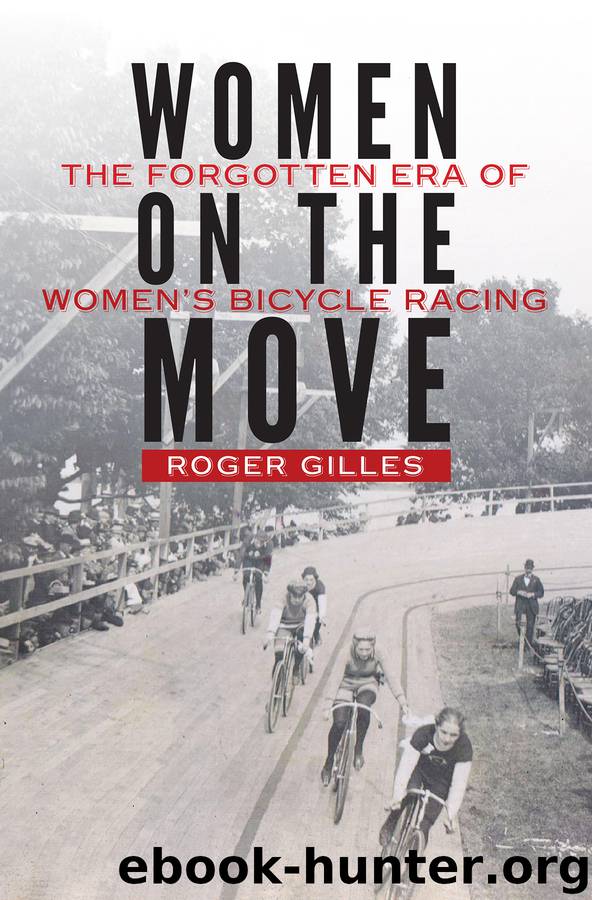Women on the Move by Gilles Roger;

Author:Gilles, Roger; [Gilles, Roger]
Language: eng
Format: epub
Tags: SPO011000 Sports & Recreation / Cycling, SPO019000 Sports & Recreation / History
ISBN: 5492196
Publisher: UNP - Nebraska
Published: 2018-08-02T16:00:00+00:00
14
It Will Be Run for Blood
The plucky Swede strained every muscle until they stood out like whipcords to win, and the German girl, with every thread in her clothing saturated with perspiration, rode like mad every foot of the route.
—“Glaw the Winner,” Toledo Commercial, July 29, 1897
Early on in the new era, Dottie Farnsworth was able to establish herself as Tillie’s chief rival largely because of Lizzie Glaw’s halting entry into the profession. In 1896 Lizzie never traveled, racing only in her hometown, Chicago. She and Tillie had debuted together at the six-day race at the Second Regiment Armory in January 1896, but they’d run in separate squads, so they didn’t go head-to-head. At the six-day race at Tattersall’s in March of that year, they’d raced together only when placed in the leaders’ squad for the final two nights. In that race, after losing a disputed battle for second to Helen Baldwin, Lizzie first showed her hardheadedness by refusing third money. Tillie won both of those races. Then, for reasons unclear, Lizzie went a full year before entering another six-day race.
Beginning in Columbus in February 1897, Lizzie committed to full-time professional racing with the backing of Cleveland Bicycles. Over the next four and a half years, Lizzie “Cleveland” Glaw entered something like forty multistage races, winning at least fifteen of them. No other rider managed to beat Tillie Anderson more than once; Lizzie did it seven times. All but two of Lizzie’s career losses came against Tillie—and indeed no one but Tillie managed to beat Lizzie more than once. The pair of them were, without question, the two greatest women racers of the 1890s.
Unlike Tillie, Dottie, and most of the other racers, Lizzie shunned the limelight—disdained it, really—and rarely spoke with the press or promoted herself in any way. As a result, very little is known about her. Born in Germany in 1875, she likely came to America in 1893 or 1894. She may have been the first woman ever to ride a bicycle on the streets of Berlin, or she may have picked up cycling only after settling on Chicago’s West Side—it depends on the source. Some say she came to America expressly to enter the great international race in Chicago in January 1896, yet she definitely ran a good number of Elgin–Aurora centuries through the summer of 1895. She herself said she picked up cycling in 1893, so it’s likely that she started shortly after immigrating.1
Few photographs of Lizzie exist; in those that do she is uniformly grim and businesslike, hunched over the wheel, her impatient gaze boring straight ahead as if all she saw or thought about was that distant finish line—or perhaps getting the studio photography session over with. There are no “glamour” shots of Lizzie. The profile that emerges from newspaper coverage is remarkably consistent: with a self-confidence bordering on arrogance, motivated not by fame or glory but by the simple promise of prize money, she insisted always on riding her own race, heedless of the escalating pulse of the band or the encouraging cheers of the crowd.
Download
This site does not store any files on its server. We only index and link to content provided by other sites. Please contact the content providers to delete copyright contents if any and email us, we'll remove relevant links or contents immediately.
| Africa | Americas |
| Arctic & Antarctica | Asia |
| Australia & Oceania | Europe |
| Middle East | Russia |
| United States | World |
| Ancient Civilizations | Military |
| Historical Study & Educational Resources |
Cecilia; Or, Memoirs of an Heiress — Volume 1 by Fanny Burney(32080)
Cecilia; Or, Memoirs of an Heiress — Volume 3 by Fanny Burney(31471)
Cecilia; Or, Memoirs of an Heiress — Volume 2 by Fanny Burney(31422)
The Secret History by Donna Tartt(18228)
Sapiens: A Brief History of Humankind by Yuval Noah Harari(13999)
Leonardo da Vinci by Walter Isaacson(12817)
The Radium Girls by Kate Moore(11639)
Sapiens by Yuval Noah Harari(5131)
How Democracies Die by Steven Levitsky & Daniel Ziblatt(4971)
The Wind in My Hair by Masih Alinejad(4852)
Homo Deus: A Brief History of Tomorrow by Yuval Noah Harari(4694)
Endurance: Shackleton's Incredible Voyage by Alfred Lansing(4518)
Man's Search for Meaning by Viktor Frankl(4300)
The Silk Roads by Peter Frankopan(4277)
Millionaire: The Philanderer, Gambler, and Duelist Who Invented Modern Finance by Janet Gleeson(4117)
The Rape of Nanking by Iris Chang(4025)
Hitler in Los Angeles by Steven J. Ross(3803)
Joan of Arc by Mary Gordon(3797)
The Motorcycle Diaries by Ernesto Che Guevara(3795)
